

I believe it is only right to begin this test-drive report with an explanation. First of all, being a reader of The Car Enthusiast you will undoubtedly know that the Mitsubishi Lancer Evolution is a very desirable car. You probably know that the VII is the latest in a line of cult rally cars for the road. So what then is the FQ-300?
It is easiest to start with the number - 300. No problem there, the car has 300lbs.ft of torque and 305bhp. Not that the regular Evo VII is exactly underpowered (282lbs.ft of torque and 276bhp). Now, the fun part - "FQ". Mitsubishi are a socially aware, allegedly a politically correct company. Which is why they couldn't possibly print the real meaning of FQ. Q is obviously for "quick". So what in the English language could the F stand for? I'm sorry, but I am not going to print the word here for you, as I'm sure your imagination can do it for me. Yes, it really is the word you are thinking.
The marketing genius that thought that moniker up was not really stretching the truth either (for a change). The Mitsubishi Lancer Evo VII FQ-300 certainly lives up to the title. The basis is the trusty 2.0-litre turbocharged four-cylinder engine found in the regular Evo VII, complete with intercooler (and obligatory water spray). In base form, this moves the not insignificant mass of the Lancer (1400 kg) from standstill to 62mph in 5.5 fun-filled seconds. The FQ however, manages it in 5.1! So, in roughly the same amount of time it has taken you to read this sentence you could be breaking the speed limit in the UK. A sobering thought indeed, as is the fact that the top speed of 157mph may sound ridiculous in today's world, but don't forget that many Evos are nowadays used on trackdays, where top end is just as important to the driver.
So where does all this extra power come from? First of all, the only reason for Japanese supercars to be restricted to 276bhp is a gentleman's agreement between the manufacturers, ostensibly to act responsibly. We all know that these powerplants are capable of more, so it is just a case of how it can be done legally. In the case of the FQ-300, the Lancer Evo VII is actually receiving an aftermarket upgrade - post-registration. The bigger numbers are extracted by careful attention to the exhaust. The system is bespoke, being made using aircraft grade stainless steel throughout with seamless 75mm diameter tubing. Apparently, this design promotes much higher gas flow, allowing the turbo to spin up more quickly which should reduce lag and increase low-down torque. I would certainly agree with that claim - considering the boost on offer there is very little lag at all, none once you learn how to drive the car properly. Amazingly, the car retains legal emissions levels thanks to the use of the original catalytic convertor.
To take advantage of the new exhaust, Mitsubishi quote changes to the "engine characteristics" by which I assume they mean cam timing, which results in bringing the turbo in earlier. This results in 10% more torque from 3000rpm and over 5000rpm, as well as better overall response and, coupled with a freer flowing air filter, allows the engine to rev freely at the top end. I can back that claim up. At the red line, it feels like the engine could rev for another thousand rpm. Damn rev limiters!
Though you will never (sensibly) extract 100% of the FQ-300's performance on the public road, it certainly is fun at 75-80%. There are other cars that can accelerate as quickly of course, and others that will eclipse the Evo in a straight line. There will not be many though that keep up with the Evo VII on a sodden November day on a twisty minor B road. As a hapless Subaru Impreza WRX driver discovered...
Four-wheel drive has been allied with turbocharging for a long while - all thanks to Audi and the Quattro. Mitsubishi though are not a company willing to rest on current technology laurels. In line with the WRC team they like to push the boundaries. Hence, helping you keep the FQ-300 (and other Evo VIIs) on the road/track is an array of clever electronics with clever sounding abbreviations: ABS, LSD, AYC and ACD. I sense a call for more explanation. Obviously ABS is the standard Anti-lock Braking System, and LSD is a Limited Slip Differential (in a way a drug itself!). On top of that we have Active Yaw Control and the superb Active Centre Differential.
Many people will not care of course what these gubbins are, but the benefits of this level of sophistication are soon obvious. The first few days with the car were quite dry for instance, and I left the ACD setting on Tarmac. In this mode, the car gripped wonderfully, yet allowed me to play with the balance of the car. During the photo shoot, the weather was less kind, and to start with we were a little worried about it all as the Evo suddenly felt like a lairy rear-wheel drive car. Adam J, our road test editor suggested playing with the ACD settings, and lo-and-behold, the car's balance was restored when on the Gravel setting. In fact, the Lancer turned out to be more fun than in the dry if anything, encouraging the driver to power through and out of corners, safe in the knowledge that the power is being carefully divided out to each wheel. As soon as the roads were dry though we switched back, as there seemed to be some unusual clonks from the differentials themselves. Unfortunately there was no snow about to try the final setting in. I wonder if Mitsubishi would be so kind to let us have the car back in January?
You see, you could actually drive this car all year round. As a car enthusiast, you will gladly put up with the stiffer than normal ride in return for exceptional handling and body control. You could also convince yourself that you are travelling fast only because the ride is better at that speed - not that I imagine many officers of the law would to be too sympathetic. You would also put up with the fuel consumption though you may need to go on a diet to afford it - I used the phrase "fuel consumption" over "fuel economy" for a very good reason. Bizarrely, the family and their luggage can easily fit into the large Lancer shell, which may help you do some explaining yourself when you sell the family saloon to buy yourself one.
Personally, I'd wait. The next generation - Evo VIII naturally - is due in the UK early in 2003. Thankfully, Mitsubishi are going to do the right thing and it will no longer be a grey import brought in by Mitsubishi UK, but a pucka type approved import. There's more - the basic Evo (I have to chuckle typing that) will be two grand cheaper than the current car, and availability will be sufficient. What's more is that Mitsubishi UK has confirmed that the FQ-300 transformation (to call it an upgrade is to under-sell it) will be available. So start saving. FQ...
SUMMARY
Performance:     
Stupendous acceleration allied to real world grunt throughout the rev range.
Engine:     
Enemies of four cylinder engines will be converted when they feel and hear this cracking engine.
Handling:     
Unquestionably one of the best handling road cars we have driven. Crucially, that phrase applies no matter what the weather.
Tactility:     
Allied with that devastatingly brilliant chassis and engine response, the Evo is a real driver's car. It loses a star due to a reluctant gearchange and the steering is a little too sensitive at autobahn speeds.
Appearance:     
The looks of the Evo VII grew on us over the course of the week with the car. However, as stunning as it is, it may attract unwanted attention. Then again, why not go the whole hog and make it as aggressive as the Evo VI?
Interior:     
The Lancer is a surprisingly nice place to be, especially with carbon fibre bits and those Recaro seats. Some of us would want to turf out the back seats and fit a roll cage... We have to dock a star though as the materials used are not worthy of the full five stars.
Safety:     
If the ABS, EBD and outright grip don't keep you out of trouble then at least you know you are surrounded by a strong saloon shell and cushioned by airbags.
Equipment:     
The stereo is decent enough. The chassis wizardry is superb. The right bits are electric and it even has air con - what more do you want? A six speed gearbox would be good.
RIVALS
The Subaru Impreza and the Mitsubishi Lancer Evo have been head-to-head for quite a while now. However, in reality they are very different cars. The current pretender to the Evo VII throne is the Subaru Impreza WRX STi Type UK. It has "only" 276bhp, but is nearly as quick in a straight line and the boxer engine sounds even better. The Scooby is also £4000 cheaper to buy. Having not driven the Subaru yet, I can not really advise which is the better car. However, I believe that the Evo wins the "showroom" battle. You'll have to decide for yourself which rally replica you want to drive.
VIDEO
Thanks to Bryan Sims we have some video footage of the Evo VII in action on the road. Please note that speed limits were adhered to. Click here to download it. Note that it is 4.12Mb in size, though the noise alone is worth it!
www.mitsubishi-cars.co.uk
Road test: 2002 Mitsubishi Lancer Evolution VII FQ300
Story by Shane O' Donoghue, images by Mark Sims
|

|
|
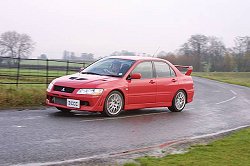
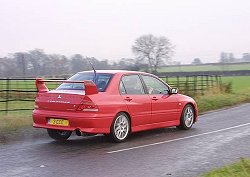
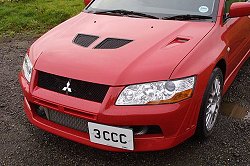
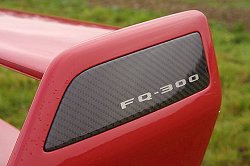
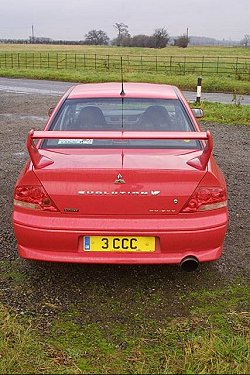
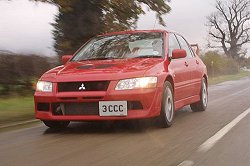
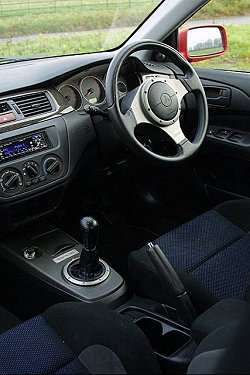
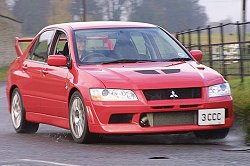
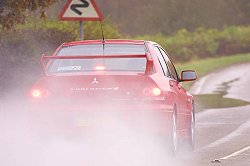
|








